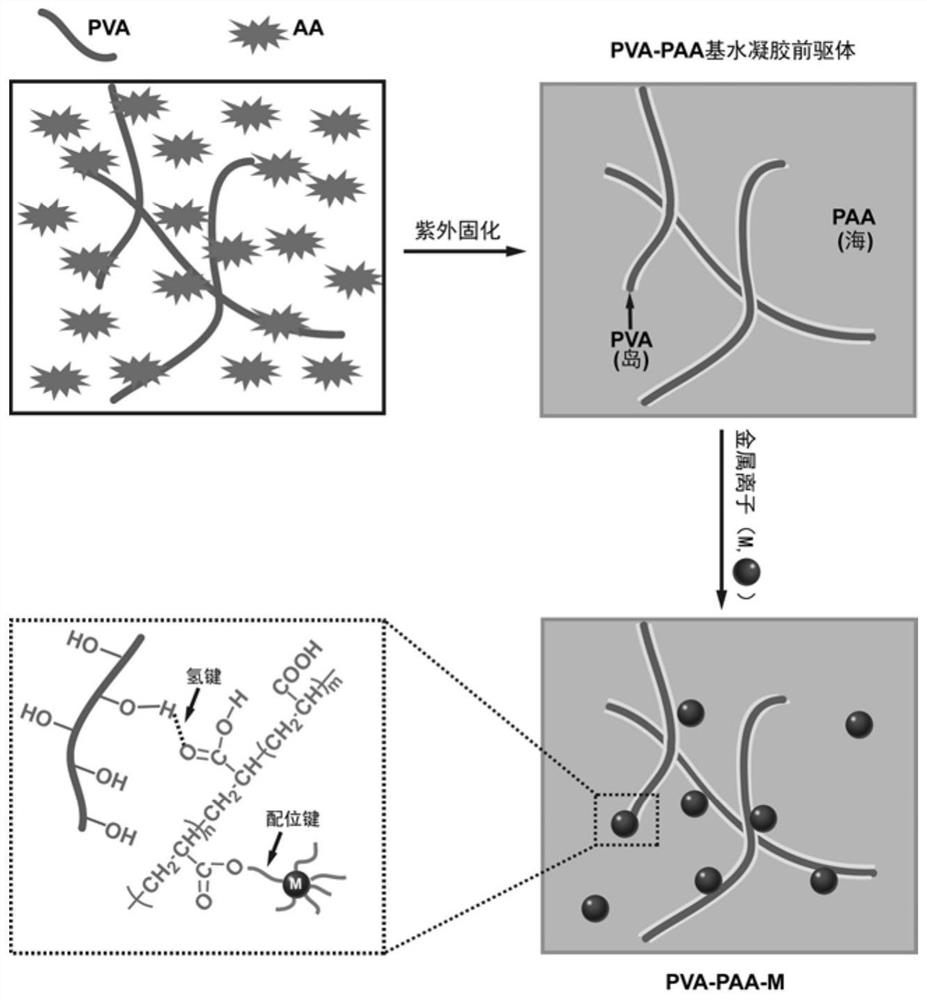A method for preparing high-strength hydrogel based on the principle of leather tanning
A hydrogel and high-strength technology is applied in the field of preparing high-strength hydrogels based on the principle of tanning and tanning, and can solve the problems of complex synthesis methods, high cost, difficulty in mass preparation, etc., and achieves simple preparation process, easy operation, The effect of promoting even immersion
- Summary
- Abstract
- Description
- Claims
- Application Information
AI Technical Summary
Problems solved by technology
Method used
Image
Examples
Embodiment 1
[0032] Step 1, preparation of PVA-PAA-based hydrogel precursor
[0033] Step 101. Dissolve 5 parts of polyvinyl alcohol in 116.5 parts of deionized water in parts by mass, then raise the temperature to 60°C and stir for 1.5 hours, then cool to 20°C to obtain a clear and transparent PVA aqueous solution; the polyvinyl alcohol Molecular weight M w =205,000;
[0034]Step 102: Add 50 parts by mass of acrylic acid monomer and 0.25 parts of 2,4-dihydroxybenzophenone to the PVA aqueous solution obtained in Step 101, and then stir at 20°C for 16 minutes to obtain PVA - AA mixture;
[0035] Step 103. Put the PVA-AA mixture obtained in step 102 under vacuum for 15 minutes, then pour it into a glass mold, and perform ultraviolet curing to polymerize the acrylic acid monomer to obtain a PVA-PAA-based hydrogel precursor The size of the glass mold is 10cm×10cm (length×width); the UV light used in the UV curing has a wavelength of 365nm, a power of 40W, a temperature of 20°C, and a time o...
Embodiment 2
[0051] Step 1, preparation of PVA-PAA-based hydrogel precursor
[0052] Step 101. Dissolve 1 part of polyvinyl alcohol in 23.3 parts of deionized water in parts by mass, then raise the temperature to 90°C and stir for 1 hour, then cool to 22°C to obtain a clear and transparent PVA aqueous solution; the molecular weight of the polyvinyl alcohol m w =205,000;
[0053] Step 102: Add 9 parts by mass of acrylic acid monomer and 0.045 parts of α-ketoglutaric acid to the PVA aqueous solution obtained in Step 101, and then stir at 22°C for 10 minutes to obtain a PVA-AA mixed solution ;
[0054] Step 103. Put the PVA-AA mixture obtained in step 102 under vacuum for 10 minutes, then pour it into a glass mold, and perform ultraviolet curing to polymerize the acrylic acid monomer to obtain a PVA-PAA-based hydrogel precursor The size of the glass mold is 10cm×10cm (length×width); the UV light used in the UV curing has a wavelength of 365nm, a power of 40W, a temperature of 22°C, and a t...
Embodiment 3
[0060] Step 1, preparation of PVA-PAA-based hydrogel precursor
[0061] Step 101. Dissolve 10 parts of polyvinyl alcohol in 233 parts of deionized water in parts by mass, then raise the temperature to 70°C and stir for 2 hours, then cool to 25°C to obtain a clear and transparent PVA aqueous solution; the molecular weight of the polyvinyl alcohol m w =205,000;
[0062] Step 102: Add 90 parts by mass of acrylic acid monomer and 0.45 parts of α-hydroxyalkyl phenone to the PVA aqueous solution obtained in Step 101, and then stir at 25°C for 20 minutes to obtain a PVA-AA mixed liquid;
[0063] Step 103. Put the PVA-AA mixture obtained in step 102 under vacuum for 20 minutes, then pour it into a glass mold, and perform ultraviolet curing to polymerize the acrylic acid monomer to obtain a PVA-PAA-based hydrogel precursor The size of the glass mold is 10cm×10cm (length×width); the UV light used in the UV curing has a wavelength of 365nm, a power of 40W, a temperature of 25°C, and a...
PUM
| Property | Measurement | Unit |
|---|---|---|
| tensile strength | aaaaa | aaaaa |
| tensile strength | aaaaa | aaaaa |
| tensile strength | aaaaa | aaaaa |
Abstract
Description
Claims
Application Information
 Login to View More
Login to View More - R&D
- Intellectual Property
- Life Sciences
- Materials
- Tech Scout
- Unparalleled Data Quality
- Higher Quality Content
- 60% Fewer Hallucinations
Browse by: Latest US Patents, China's latest patents, Technical Efficacy Thesaurus, Application Domain, Technology Topic, Popular Technical Reports.
© 2025 PatSnap. All rights reserved.Legal|Privacy policy|Modern Slavery Act Transparency Statement|Sitemap|About US| Contact US: help@patsnap.com

